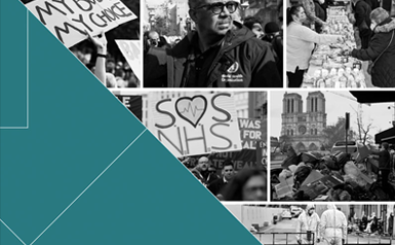Photo: Bret Hartman / TED
Last night, we were delighted to host Edelman technology clients at a wonderfully Reithian evening of information, education and entertainment, courtesy of the day one speeches at TED2017, streamed to a cinema audience in London’s West End.
The bill was nothing if not diverse, ranging from a former chess grandmaster to a former Chief Rabbi, via a rock band and a futurologist. Oh, and all introduced by a balletic display of man + robot (arm) dancing to a live cello sonata. Apt, as the overarching theme, ‘One Move Ahead’, explored a man and machine future filled with all the natural fears of – and prejudices towards – technological progress of a tribe deeply vested in maintaining the status quo. Which, in the West, includes all of us to some extent. But it ultimately landed upon a common message of empowerment – that we are shaping, and must continue to shape, our future. To not fear innovation, but to reconnect with our human creativity to enhance it. To not assume as inevitable a dystopian future, but to take individual responsibility now for making it better. To question our cultural assumptions, and to maintain an unflinching pursuit of the truth. And, ultimately, to look beyond the self and to each other to build a future without fear.
Powerful stuff for a Tuesday. Here’s my five top takeaways from the talks, relevant to the world of technology communications:
1. Concrete experiences bridge the disconnect between today and tomorrow
By turning imagined futures into physical experiences today, Anab Jain and her team at Superflux shift perceptions and influence policy at the highest levels. By creating a noxious sample of air from ‘the future’ based on current pollution growth rates in the UAE, Anab gave that country’s leaders a stark vision of tomorrow, which had a firm influence on their resultant green energy policy. Experiences speak louder than words – how can we as communicators place physical experiences at the heart of campaign design? See the recent Give a Beep campaign by Edelman Deportivo for inspiration.
2. Dream big – it’s what humans do best
Chess grandmaster Garry Kasparov reminisced on the “golden age” when “machines were weak and my mind was strong.” That was before IBM’s Deep Blue beat him – on the second attempt, he took pains to point out – in 1997 prompting sensational headlines around the world of the ‘brain’s last stand’. This media narrative of man versus machine has barely changed in the intervening 20 years. But Garry’s lesson for us, from a man who had fought a futile battle against technology and lost, was not to fear or fight the inevitable rise of intelligent machines: “We don’t get to choose when progress starts or stops”. As he put it: “We must face our fears to get the most out of machines, and we must conquer our fears to get the most out of humanity”. And this means embracing the uniquely human powers of imagination and creativity – qualities that replicants will never truly replicate.
3. Find a sandbox
Whatever you think of OK Go’s music, their videos are unarguably unmissable, and we were treated to a dissection of their creative process in developing these works of video art. Actually, the main lesson was to ditch the process. The best ideas, argued frontman Damian Kulash, are serendipitous – emerging from a period of experience and experimentation. Trying to come up with a good idea on paper, and then strictly planning a process for how you will economically and punctually bring it to life, leads to unoriginal thinking and imperfect execution. So, when the band shot a video in zero gravity on the ‘vomit comet’ astronaut training plane, they didn’t plan. Instead, they spent a third of their entire budget just “playing” on the plane for a week to see what would be possible in this strange zero G world, before capturing the perfect shots that could never have been planned without experience. This struck a chord with me. A communications agency has a duty of care to respect a client’s time and budget, which means planning down to the last minute and the last pound. And rightly so. But for true originality to emerge, we must plan for an unplanned period in campaign development. Build a sandbox to play in and see what happens.
4. Easy choices, hard life. Hard choices, easy life
Tim Ferriss shared a very personal story of his battle with bipolar disorder which has seen him face more than 50 periods of depression to date – a ‘healthy’ person typically faces 5-6 in a lifetime, he told us. Tim espoused the virtues of stoicism in helping him to cope with his condition, specifically developing an ability to distinguish between that which he can and can’t control, and to focus his energies on influencing the former. He also shared his framework for making tough decisions by weighing up not just its pros and cons, but also the opportunity cost of not taking a course of action. Public relations is a fast and often frenetic occupation, of cyclical highs and lows, and the ultimate decision of whether a journalist will publish or not remains by definition (unlike advertising) outside of our control. To enjoy a long and rewarding career in this exciting sector, it’s wise to have a personal philosophy to maintain perspective and focus energies on that which you can influence. Making difficult decisions comes as part and parcel of that, and convincing clients to join you on that journey can create its own tensions. Tim’s personal philosophy – grounded in the tenets of stoicism – can teach us much. And by thinking in terms of ‘what would we miss if we didn’t do this’, rather than just ‘what would we gain if we did do this’, can help us to ensure we’re continually challenging ourselves and our clients to make hard choices.
5. Storytelling can heal the divisions in society
Closing the session, Lord Rabbi Jonathan Sacks offered an explanation for today’s divided society, for the deep fears of immigration, and the ‘pull up the drawbridge’ mentality associated with Brexit or President Trump’s wall. He believes that the strength of our common identity – of where we came from and what we stand for – has deteriorated, and that we have become lax in telling these stories. And the natural consequence of a shaky understanding of our collective self is fear and suspicion of newcomers. Lord Rabbi Sacks believes that “We’ve got to get back to telling our story,” as a collective ‘we’ rather than as the isolated self. It was an empowering call for togetherness: “We can face any future without fear so long as we know we won’t face it alone.” Music to the ears of this professional communicator that storytelling has the power to heal divisions in society. In practice, we have a responsibility to press clients to not just tell their firm’s own story in isolation – it’s products, services and company news. They must also consider where their company’s story sits within the societies they serve. Influential brands and their high-profile executive leaders can serve as ambassadors for what we, as a society, collectively believe and value. By connecting to the collective story, their company’s own story will be all the more authentic and relevant as a result.



